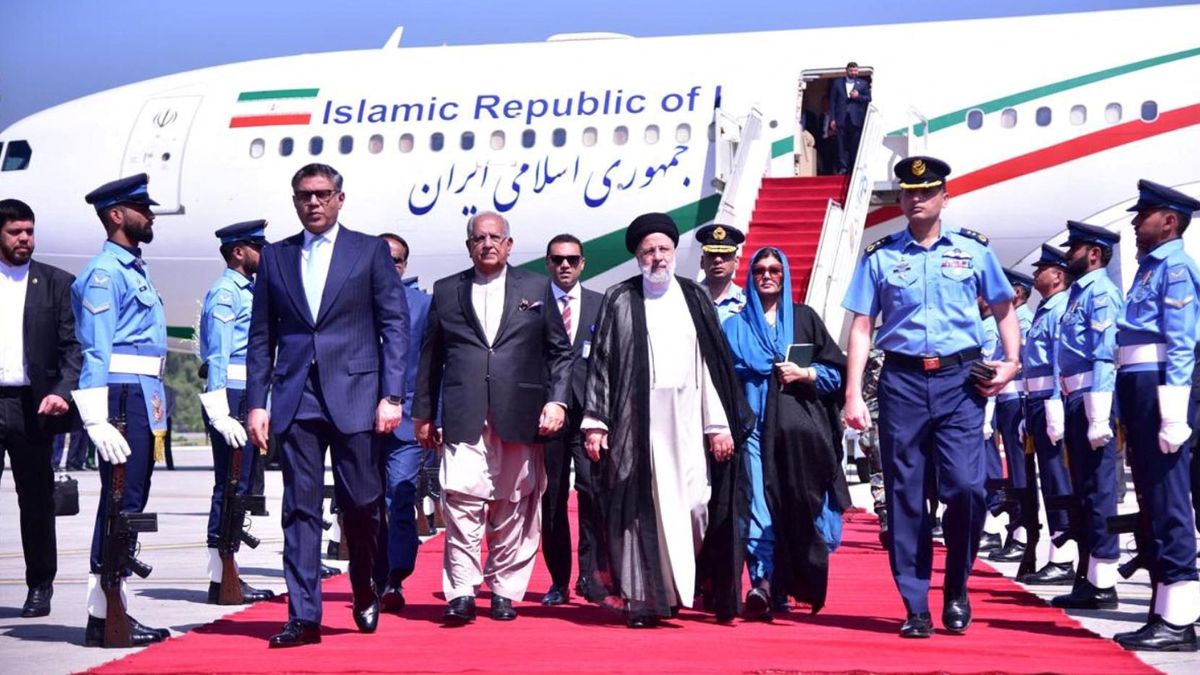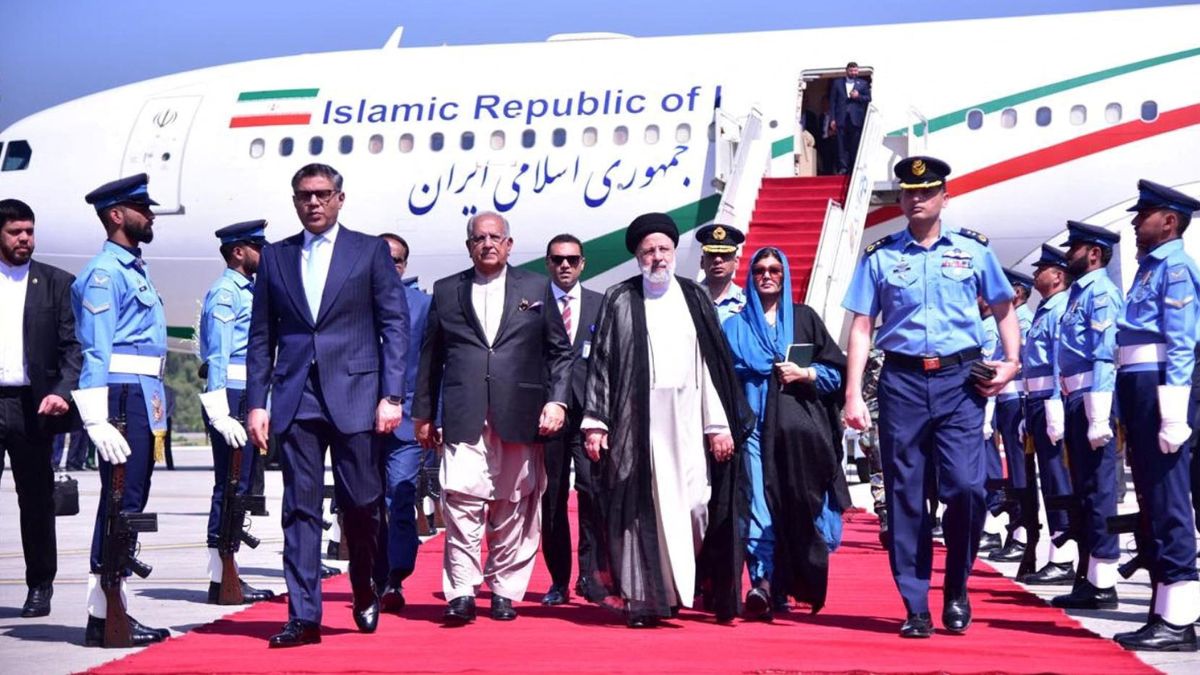Iran’s perfectly synchronised choreography, Operation True Storm, was over in a few hours on April 13. Around a week later, Israel retaliated, but it turned out to be a muted response.
On April 19, Iran intercepted three drones but no missiles, as explosions were heard near Qahjavarestan, close to Isfahan airport and the Shekari Army airbase.
Iran’s barrage of 170 drones, 30 cruise missiles and around 120 ballistic missiles against Israel didn’t trigger a wider conflagration in West Asia. Israel’s muted response isn’t expected to plunge the region into a bloody abyss either.
Honestly, neither Iran nor Israel can afford a war.
Iranian attack raises questions
Iran’s purportedly audacious and first direct attack against Israel raises several questions.
First, Iran had informed its neighbours and the United States (US) about the attack 72 hours ago. American President Joe Biden told the media on April 12 that he expected an Iranian response “sooner rather than later”. The USS Dwight Eisenhower aircraft carrier had already sailed through the Red Sea towards Israel to counter an expected Iranian response.
A day later, Iranian foreign minister Hossein Amirabdollahian said that Iran gave its neighbours and the US advanced notice. The Turkish foreign ministry claimed to have spoken to the US and Iran.
According to a Turkish diplomatic source, the attack wasn’t a “surprise” as Iran has said that its “reaction would be a response to Israel’s attack on its embassy in Damascus and that it would not go beyond this”. However, a senior Biden official denied the claims, “That is absolutely not true. They did not give a notification.”
Second, the quality and precision of the Iranian drones and cruise and ballistic missiles used in the attack. Israel claimed to have destroyed 99 per cent of the projectiles. According to US military sources, 50 per cent of Iran’s projectiles had technical failures, The Intercept reported.
Iran used both the slow-flying Shahed-136 and the faster jet-engine Shahed 238 Kamikaze (suicide) drones, which were all shot down. Russia has been using the Iran-supplied Shahed-136 to devastating effects against Ukraine. Still, the loitering munitions couldn’t breach the three-tier Israeli missile defence system of Arrow 2 and 3, David’s Sling and Iron Dome.
Ukraine, which has a massive land area of 603,550 sq km compared to Israel’s 21,671 sq km, neither has such a sophisticated missile defence system nor is assisted by NATO warships or fighter jets that can destroy the Shaheds.
In fact, the US, the United Kingdom (UK), France and Jordan destroyed most Iranian drones and missiles in an operation coordinated by the US Central Command at Qatar’s Al Udeid Air Base. Two F-15 squadrons were forward deployed to West Asia with 50 per cent of the jets in Jordan. Besides, the USS Carney and the USS Arleigh Burke also participated in the mission from the Mediterranean.
Therefore, the effectiveness of Shahed drones becomes questionable if used against a superior adversary backed by the US.
Iran has the largest and most diverse ballistic and cruise missile inventory in West Asia and can also produce an ICBM. But only nine ballistic missiles, including five that hit the Nevatim Air Base and four that struck the Negev Air Base, evaded the Israeli defence shield.
Iran used the Paveh cruise missile and the Kheibar Shekan, Emad and Ghadr-1 MRBMs but not the more advanced and powerful Sejjil-1 and Shahab-3 MRBMs. However, their effectiveness hasn’t been proven.
Without naming the missiles that dodged the Israeli defence, Iran’s state news agency, Press TV, claimed that they were hypersonic. Hypersonic weapons, either hypersonic glide vehicles (HGVs) or hypersonic cruise missiles, are difficult to intercept because of their manoeuvrability and unexpected trajectory.
Iran unveiled the Fattah MRBM in June 2023, claiming it was hypersonic despite being a manoeuvrable re-entry vehicle. In November that year, Iran unveiled the Fattah-2, claiming it was an HGV.
However, Iran’s missiles and its depleted air force with old fighter jets aren’t powerful enough to be a game changer in a war with Israel unless its proxies—Hezbollah (Lebanon), Kataib Hezbollah and Asaib Ahl al Haq (Iraq) and Harakat Hezbollah al Nujaba and Kataib Sayyad al Shuhada (Syria)—join in and Tehran launches a sudden attack.
Third, the highly choreographed attack was never meant to fuel the volatile West Asia situation. Iran knows the effectiveness of the Israeli missile shield and called the assault an act of self-defence against the destruction of its Damascus embassy and said that the “matter can be deemed concluded”. No death or significant damage was reported during the spectacle of terrifying fireworks. The US, Israel and their allies knew about the attack and had enough time to counter it.
The Islamic Revolutionary Guards Corps (IRGC) and Iran’s supreme leader Seyyed Ali Hosseini Khamenei couldn’t afford to look weak after Israeli F-35s bombed the Iranian consulate building in Damascus.
The strike killed seven IRGC officers, including Brigadier General Mohammad Reza Zahedi, the commander of the elite Quds Force in Syria and Lebanon, and his deputy Brigadier General Mohammad Hadi Haji-Rahimi.
Zahedi was eliminated because Israel believed that he planned and executed the October 7 Hamas attack. After his assassination, the Coalition Council of Islamic Revolution Forces, the biggest hardline group consisting of former IRGC personnel and its Basij militia, praised Zahedi for his “planning and executing Operation Al-Aqsa”.
Iran had no option but to stage a ‘harmless’ strike to maintain its image of a regional powerhouse that is against Israel and supports Palestinians and convey a message of strength to Iranians. If the IRGC seriously wanted to harm Israel, it would have been a synchronised attack involving its proxies in Syria, Lebanon, Iraq and Yemen.
Similarly, during Operation Martyr Soleimani on January 8, 2020, the IRGC launched around 12 Fateh-313 and Qiam SRBS at the al-Asad Airbase and another airbase in Ebril, Iraq, in response to the assassination of Quds Commander Major General Qasem Soleimani by an American MQ-9 Reaper drone.
However, neither any US personnel were killed nor major damage reported with Iran already notifying the US and Iraq 10 hours in advance. With even a maverick like Donald Trump not responding to the attack, its futility was evident.
The falsity of Iran’s threat of an “immediate” and “maximum” response if Israel retaliated was proved when Tehran downplayed the explosions over Isfahan and indicated that it didn’t want to retaliate. Iran didn’t even name Israel and termed the attack “infiltration”. “The foreign source of the incident has not been confirmed. We have not received any external attack, and the discussion leans more towards infiltration than attack,” an Iranian official told Reuters.
Iran can’t sustain or win a war with Israel
Iran will not be able to sustain or win a war against a militarily superior Israel and its Western allies also due to economic reasons.
The rial has plummeted 12 times its value since 2018, when Trump withdrew from the Joint Comprehensive Plan of Action, or the nuclear deal, signed between Iran, the P5+1 and the European Union (EU) in July 2015.
According to the IMF, Iran’s forex reserves, including gold, were $24.3 billion as of March 1. The inflation rate in October 2023 was the highest in two years. Central Bank of Iran data showed that inflation jumped to 54.8 per cent for the month ended October 22.
According to a November 2023 World Bank report , poverty has dramatically increased due a “lost decade” of economic growth, Western economic sanctions, swings in international oil prices and COVID-19. “The country has seen almost 10 million people slide into poverty, exacerbating social inequities. Forty per cent of Iranians are vulnerable to falling into poverty.”
In another report , the World Bank said that the “economy is continuing its oil-driven growth in 2023-24, helping employment to return to pre-pandemic levels”. However, “inflation remained elevated despite tighter monetary policy” and “economic prospects are hindered by long-lasting structural challenges exacerbated by economic sanctions, heightened geopolitical tensions and the impact of climate change”.
Though Iran’s economic growth has been “resilient” in the last four years and benefited due to oil sector growth, services and manufacturing, sanctions have limited technology transfer and investment to boost productivity.
GDP growth increased to 5.1 per cent year-on-year in the first half of 2023-24 but is predicted to moderate to an annual average of 2.8 per cent from 2024-25 to 2026-27. “The initial boost in oil production and exports in 2023-24 is projected to moderate significantly with a similar spillover effect into the non-oil sector,” the World Bank said.
Iran has been reeling under severe sanctions against its nuclear programme, which the West suspects Iran will use to make a nuke. The most comprehensive sanctions, targeting thousands of people and Iranian and foreign companies, prohibit almost all trade between the nations, block Iran’s assets in the US and ban American foreign assistance and arms sales.
The Atomic Energy Organisation and other companies linked to Iran’s N-programme, several banks, including the Central Bank of Iran, the National Iranian Oil Company, ministries of defence and petroleum, IRGC, Quds Force and President Ebrahim Raisi have been targeted.
Now, the US and the UK have announced more curbs on Iran targeting 16 individuals and two entities helping its drone production. The US also further restricted Iran’s access to “low-level technology”. More items requiring a licence for export or re-export to Iran, including items made abroad with American technology, have been banned.
The UK has sanctioned seven individuals and six entities, including the Armed Forces General Staff and the Islamic Revolutionary Guard Corps Navy.
Meanwhile, the EU has agreed to impose new sanctions on Iran’s drone and missile producers. European Council president Charles Michel said, “The idea is to target the companies that are needed for the drones and the missiles.”
Israel also can’t afford another war
Israel has faced increasing global criticism against its incessant and indiscriminate bombing of Gaza, which has killed around 34,000, mostly women and children, and driven around one million Gazans to the rink of starvation. Relations between Biden and Israeli Prime Minister Benjamin Netanyahu have soured though Washington continues to assist Tel Aviv with arms and ammunition and on international fora.
Hamas’s strength and military capabilities have been depleted, but it’s undefeated and continues to hold more than 120 hostages.
Netanyahu, who’s facing calls for resignation and to get back the hostages, is losing the faith of Israelis. Two opinion polls this month showed that around 75 per cent of the public wants him to quit and 50 per cent prefers an early election.
A Kan public broadcaster poll showed that 42 per cent of respondents want Netanyahu to resign immediately and 29 per cent want his resignation after the war with Hamas end. Besides, 44 per cent prefer an election within a few months. A Channel 12 poll found that 50 per cent want an early election.
The Israel-Hamas war, in its seventh month with no signs of victory or decimation of the terrorist organisation, has impacted the economy.
Israel has already spent around $60 billion on the war. GDP tanked by 19 per cent in the fourth quarter of 2023. Private spending decreased by 26.3 per cent, exports by 18.3 per cent and investment in fixed assets by 67.8 per cent, per the Central Bureau of Statistics.
Contrary to expectations of a 3.5 per cent growth, Israel’s economy grew by two per cent last year. The Bank of Israel estimates a growth of two per cent for 2024 while the Finance Ministry sees it at 1.6 per cent.
Israel can’t afford a third front by attacking Iran after its war with Hamas, the frequent clashes with Hezbollah and the grim economic situation.
The writer is a freelance journalist with more than two decades of experience and comments primarily on foreign affairs. Views expressed in the above piece are personal and solely those of the writer. They do not necessarily reflect Firstpost’s views.


)




)
)
)
)
)
)
)
)